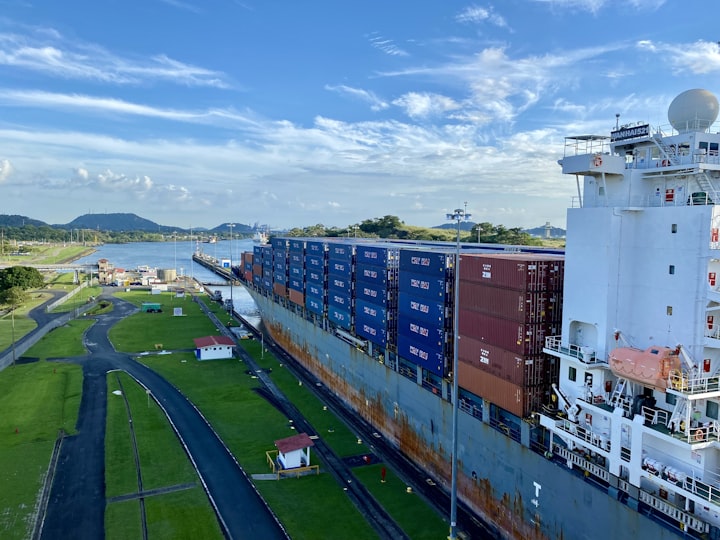
Navigating the Narrow Path: The Shrinkage of the Panama Canal and Its Trade Ripples
In the realm of global trade, few passages hold as much significance as the Panama Canal. This engineering marvel has long been the linchpin connecting the Atlantic and Pacific Oceans, enabling ships to bypass the lengthy and treacherous journey around the southern tip of South America. However, recent developments have sent shockwaves through the maritime world – the Panama Canal is shrinking.
The very concept of the Panama Canal shrinking might sound like a tall tale from a fictional land, but in our newly resized reality, the once-mighty waterway has seen its dimensions diminished. While ships used to glide through its locks with relative ease, the narrowing of the canal's width and depth has presented a new challenge – a bottleneck that threatens to dam the flow of global commerce.
Imagine a bustling corridor that once accommodated the largest cargo vessels now struggling to fit even the mid-sized ships. As trade routes have grown accustomed to the Panama Canal's generous dimensions, the sudden reduction has created a tug-of-war between the needs of modern shipping and the canal's shrinking capacity.
Ten Facts: The Importance of the Panama Canal for Trade by Ships
Global Connectivity: The Panama Canal acts as a vital link connecting the Atlantic and Pacific Oceans, enabling ships to bypass the lengthy and treacherous journey around the southern tip of South America.
Time and Cost Savings: By using the Panama Canal, ships can significantly reduce their travel time, which translates into cost savings for businesses involved in international trade.
Larger Cargo Vessels: The canal expansion in recent years has allowed larger cargo vessels known as "New Panamax" ships to pass through, increasing the capacity and efficiency of shipping operations.
Trade Diversification: The canal facilitates the movement of goods between regions, encouraging diversification of trade partners and markets, leading to a more balanced global economy.
Access to Growing Markets: Developing countries and emerging markets have gained easier access to major trading partners due to the shortened shipping routes provided by the canal.
Energy Efficiency: Using the canal reduces fuel consumption, which is environmentally beneficial and economically advantageous for shipping companies aiming to reduce operating costs.
Just-in-Time Logistics: The canal's efficient transit times support just-in-time manufacturing and supply chain strategies, enhancing the overall efficiency of industries.
Economic Growth: The canal has been a catalyst for economic growth in Panama, providing a source of revenue and boosting the country's infrastructure development.
Reduced Congestion: By providing an alternative route, the Panama Canal helps alleviate congestion at other major ports, enhancing overall maritime efficiency.
Stability and Security: Having multiple trade routes ensures greater resilience in the face of geopolitical tensions, offering a reliable and secure passage for global trade.
The ripples of this change have reverberated across the globe. Once smooth sailing has given way to traffic jams on the high seas as cargo ships stack up, waiting their turn to pass through the now-constricted canal. The domino effect on trade has been staggering – delayed shipments, frustrated supply chains, and the haunting specter of delivery cargo ships piling up at both ends of the canal, resembling an impatient caravan stranded at a tollbooth.
But how did this shrinking saga unfold? Some theorists point to the influence of an eccentric weather phenomenon known as the "Rainbow Mist." Rumors swirl that a mysterious fog swept through the canal's surrounding lands, causing the soil to compact and the waters to recede. It's almost as if the mist created a magical vacuum, drawing the once-spacious canal into a new, shrunken reality.
Ten Reasons for the Shrinkage of Water in the Panama Canal
Climate Change: Rising global temperatures could have led to increased evaporation rates, reducing water levels in the canal.
El Niño/La Niña: The periodic weather phenomena of El Niño and La Niña can disrupt normal precipitation patterns, potentially impacting the canal's water levels.
Deforestation: The clearing of forests near the canal's watershed could have disrupted natural water retention, affecting overall water availability.
Droughts: Extended drought periods in the region may have contributed to decreased water inflow, impacting the canal's water levels.
Human Activities: Increased water consumption for agriculture, industry, and urban growth in the region might have reduced available water for the canal.
Sediment Accumulation: Sediment buildup over time could have reduced the canal's water-carrying capacity, leading to shallower waters.
Land Subsidence: Subsidence of the land around the canal due to geological factors could have impacted water levels and flow.
Natural Variability: Natural fluctuations in precipitation levels can affect water availability and contribute to temporary shrinkage.
Water Management Practices: Changes in water management strategies upstream could have altered the water supply reaching the canal.
Inadequate Infrastructure: Insufficient maintenance and upkeep of the canal's infrastructure might have led to issues with water retention and flow.
Economic pundits, however, have a more pragmatic perspective. They argue that the canal's shrinking is symbolic of a broader trend – the delicate balance between man's feats of engineering and nature's unruly whims. The scramble to widen and deepen the canal to accommodate the burgeoning cargo ships reflects humanity's ongoing struggle to master the natural world, while the canal's shrinking serves as a reminder that Mother Nature might have a few tricks up her sleeve.
What does all this mean for the world of trade? Well, picture this: cargo ships laden with goods from distant lands awaiting their turn to traverse the diminished canal, forming a floating parade of international commerce. The delays have given rise to innovative solutions – floating marketplaces, onboard entertainment extravaganzas, and even a "Canal Carnival" featuring maritime clowns and acrobatics.
As absurd as this scenario may seem, it embodies the spirit of adaptability that humankind has always displayed in the face of challenges. The shrinking Panama Canal might slow the pace of trade, but it can't quell the human capacity for creativity and ingenuity.
In conclusion, the shrinking of the Panama Canal may be a quirky twist in the tapestry of global trade, but it highlights the delicate dance between our engineered marvels and the forces of nature. While it may take time to adjust to the canal's new dimensions, the world will find its rhythm once again, and the show will go on – even if that show features cargo ships in a floating parade.
The canal may have shrunk, but humanity's ability to navigate the waters of change remains as expansive as ever. After all, even in the realm of trade, a little twist of the fantastical can lead to a story worth telling.






Comments
There are no comments for this story
Be the first to respond and start the conversation.